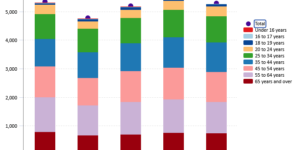 Experts fear that aging U.S. dams may not be able to handle the extreme weather events associated with climate change. Scientists warn that some U.S. coastal cities could experience daily flooding by the year 2100.
Experts fear that aging U.S. dams may not be able to handle the extreme weather events associated with climate change. Scientists warn that some U.S. coastal cities could experience daily flooding by the year 2100.
***
Can aging U.S. dams withstand more frequent extreme weather events?
The collapse of two Michigan dams in May following heavy rainfall has triggered concern that aging dam infrastructure in the U.S. may not be able to handle the increased precipitation and storms associated with climate change.
The dam failures caused mass flooding that destroyed 150 houses, led to the evacuation of thousands of people and cost more than $200 million in damage.
“A lot of the country’s infrastructure systems were built during a time when these kind of weather events were considered rare and didn’t present a significant threat,” Hiba Baroud, a professor of civil and environmental engineering at Vanderbilt University, told CNBC.com. “These dams are aging and need to be maintained, upgraded and in the most extreme cases, the entire design must be revisited.”
The 91,000 dams in the U.S. earned a “D” for safety in a 2017 report from the American Society of Civil Engineers. The ASCE estimated the cost of fixing the dams whose failure would threaten lives at roughly $45 billion, and the cost of fixing all aging dams at over $64 billion.
Back in November 2019, The Associated Press announced that its more than two-year investigation had found scores of dams nationwide in hazardous condition.
AP said its review of federal data and reports obtained under state open records laws identified 1,688 high-hazard dams rated in poor or unsatisfactory condition as of 2018 in 44 states and Puerto Rico. The actual number is almost certainly higher, as some states declined to provide ratings for their dams, claiming exemptions to public record requests. Others haven’t rated all their dams due to lack of funding, staffing or authority.
AP examined inspection reports for hundreds of high-hazard dams in poor or unsatisfactory condition. Those reports cited a variety of problems: leaks that can indicate a dam is failing internally; unrepaired erosion from past instances of overtopping; holes from burrowing animals; tree growth that can destabilize earthen dams; and spillways too small to handle a large flood. Some dams were so overgrown with vegetation that they couldn’t be fully inspected.
Sources: “More dams will collapse as aging infrastructure can’t keep up with climate change,” CNBC.com, May 21, 2020; “AP: At least 1,680 dams across the US pose potential risk,” The Associated Press, Nov. 11, 2019
***
Sea-level rise will redefine the coastline.
By 2100, city streets in some coastal U.S. cities could experience flooding every day, making urban waterfronts practically uninhabitable, warns a recent study published in the journal Scientific Reports.
If sea levels continue to rise as expected, extreme flooding events in some coastal areas of the country could double every five years, according to researchers from the U.S. Geological Survey, the University of Illinois at Chicago and the University of Hawaii.
The scientists predict that today’s “once-in-a-lifetime” extreme water levels, which are currently reached every 50 years, may be reached every year in 70 percent of U.S. coastal regions by 2050, and every day at high tide for 90 percent of the U.S. coastline by 2100, based on well-established sea-level projections.
“For most locations around the U.S., we found that 5-10 centimeters [around 2-4 inches] of sea-level rise can double the chances of flooding. Combining this with sea-level projections over time, it appears that the chances of extreme flooding in most locations around the U.S. will double every five to 10 years,” the study’s authors told Newsweek.
According to the researchers, cities in low-latitude, low-elevation regions will be the most vulnerable, such as Honolulu, New Orleans and San Francisco. They added that some cities along the East Coast—such as Miami, Charleston and Atlantic City—were “highly vulnerable.”
Source: “Some Coastal U.S. Cities Could Experience Flooding Every Day by 2100 If Sea Levels Rise as Expected, Scientists Say,” Newsweek, April 17, 2020




















 Most Distracting Holiday Songs for Drivers Ranked
Most Distracting Holiday Songs for Drivers Ranked  Dear Elon and Vivek: Insurance Commissioners Urge DOGE to Ditch FIO
Dear Elon and Vivek: Insurance Commissioners Urge DOGE to Ditch FIO  2025 Underwriting Profit and ‘Shop-a-Palooza’ Predicted for Auto Insurance
2025 Underwriting Profit and ‘Shop-a-Palooza’ Predicted for Auto Insurance  Surviving the ‘Silver Tsunami’: Closing the Talent, Skills Gap in Underwriting
Surviving the ‘Silver Tsunami’: Closing the Talent, Skills Gap in Underwriting 





